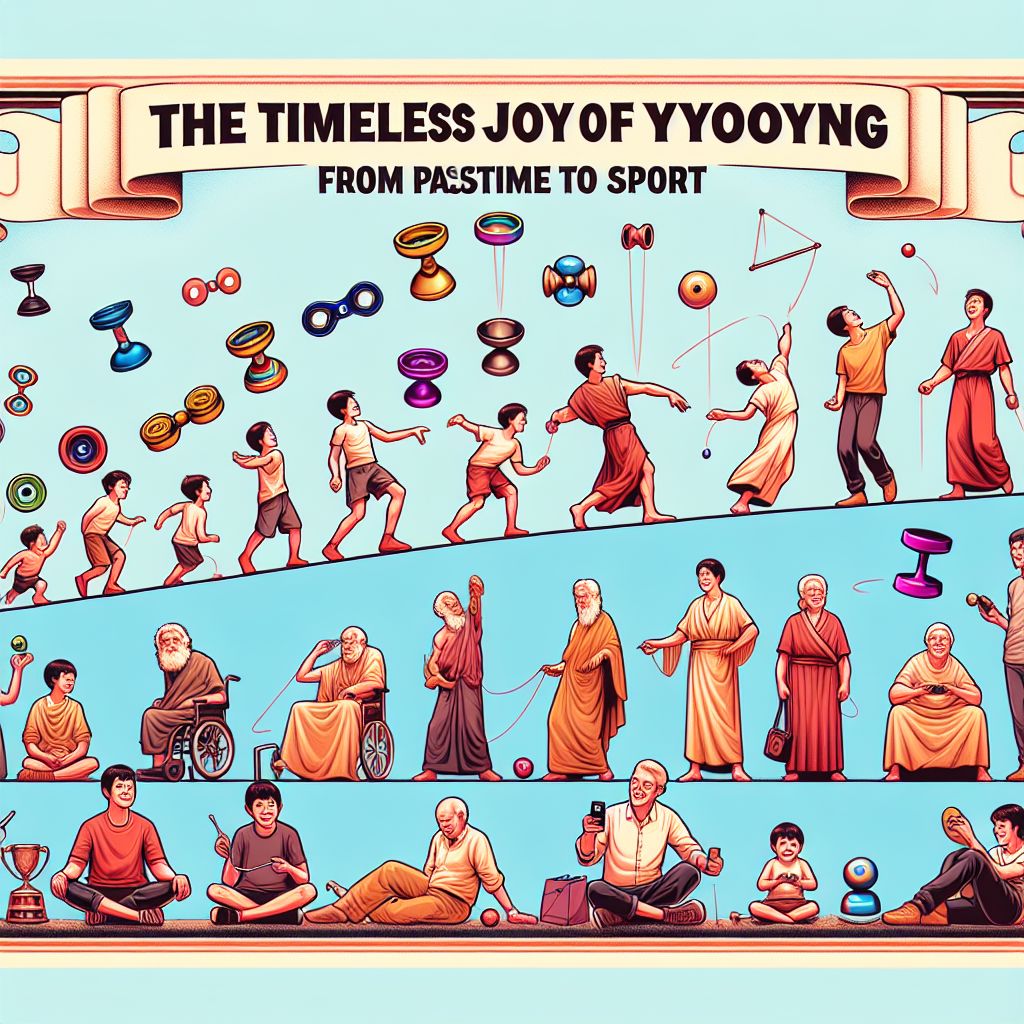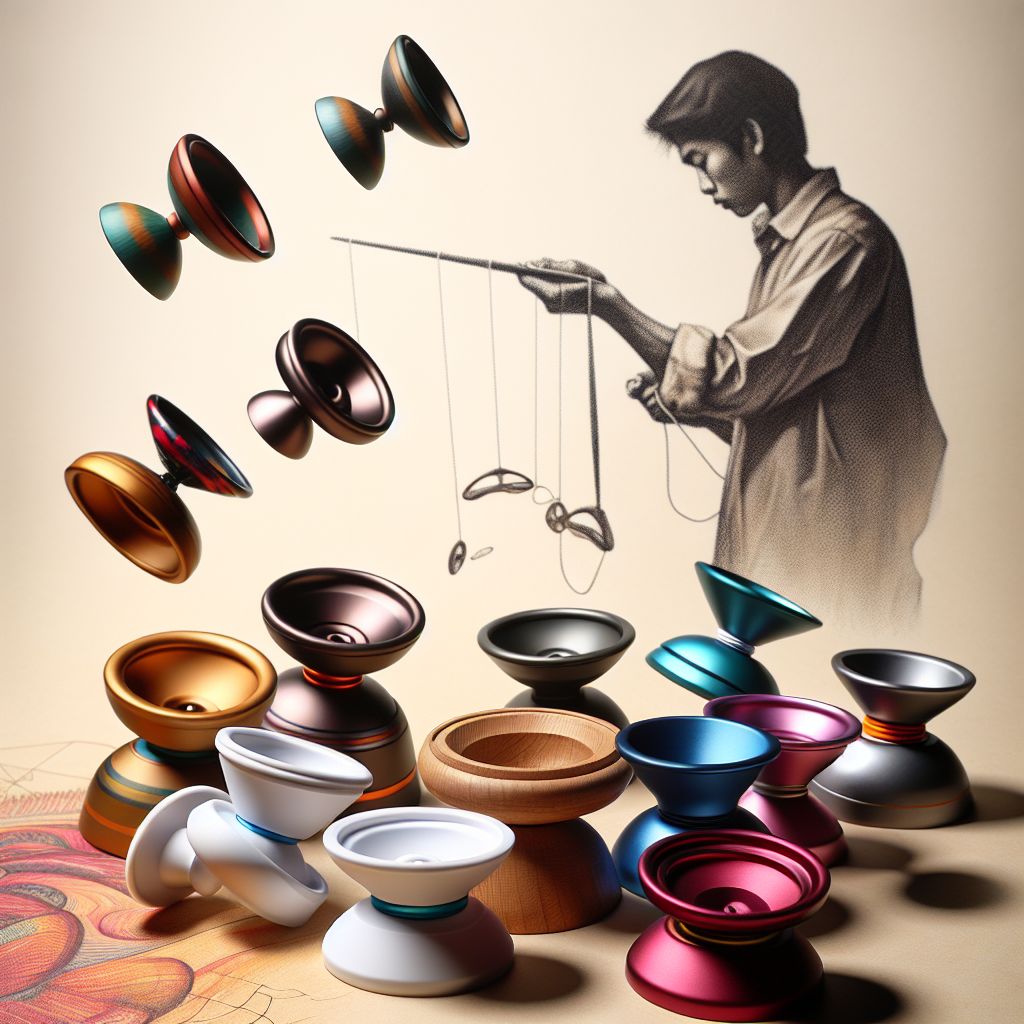- Introduction to Yoyoing
- Types of Yoyos
- Basic Yoyo Mechanics
- Choosing Your First Yoyo
- Yoyo Maintenance
- Basic Yoyo Tricks and Techniques
- Practice Tips and Progress Tracking
- Joining the Yoyo Community
- Safety Precautions
- Resources for Further Learning
Introduction to Yoyoing

The origin of the yoyo is shrouded in a bit of mystery, but its existence dates back at least 2,500 years. Ancient Greek artifacts depict images of people playing with yoyos, suggesting that yoyos may have evolved from a form of come-and-go amusement to an object of skillful manipulation. Fast forward to the 20th century, the yoyo underwent a significant transformation. In the 1920s, Pedro Flores, a Filipino immigrant to the United States, popularized the modern design we recognize today and kickstarted the yoyo's journey into mainstream culture.
Throughout the 20th and into the 21st century, yoyoing has evolved from a children's pastime into a bona fide sport and hobby, complete with competitions, dedicated communities, and advanced techniques. With the advent of the internet, the spread of yoyoing has accelerated, and online tutorials have made learning more accessible than ever. Professional yoyoers now showcase gravity-defying tricks, attracting audiences worldwide and inspiring a new generation of enthusiasts.
As a beginner, the appeal of yoyoing lies not only in its rich history and the thrill of mastering tricks but also in its benefits. Yoyoing enhances hand-eye coordination, fine motor skills, and even patience and perseverance as one practices to perfect various maneuvers. Moreover, it's a portable hobby, meaning you can take your yoyo almost anywhere, providing a unique and constructive way to pass the time. The joys of yoyoing are plentiful, from the satisfaction of landing a new trick to the community aspect of sharing techniques and experiences with fellow yoyoers.
Types of Yoyos

For those new to yoyoing, understanding the different types of yoyos on the market is crucial in selecting the right one to start with. The two main categories of yoyos are "responsive" and "unresponsive." Responsive yoyos are designed to return to the hand with a simple tug on the string, making them ideal for beginners. They allow newcomers to focus on the basics without the complexity of additional maneuvers required to bring the yoyo back. Unresponsive yoyos, on the other hand, are designed for advanced players. They won't return to the hand with a tug; instead, a trick called a "bind" is necessary to make the yoyo come back up, which allows for a wider range of tricks but requires more skill.
When we delve into the shapes of yoyos, there are three primary designs to consider:
- Imperial: This shape is the classic design that many people picture when they think of a yoyo. It has a narrow loop around the axle, which makes it well-suited for basic looping tricks. Its slim profile is iconic but can be more challenging for string tricks.
- Butterfly: The butterfly shape features a wider profile with a large gap, making it easier to catch the yoyo on the string. This design is excellent for beginners who want to learn string tricks and is the preferred shape for many modern yoyoers.
- Modified: Falling somewhere between the imperial and butterfly, the modified shape is a hybrid that is versatile for different styles of play. It can accommodate a range of tricks, making it a good all-rounder for those who want to explore various aspects of yoyoing.
For beginners, the importance of choosing the right type of yoyo cannot be overstated. A responsive butterfly-shaped yoyo is often recommended as it combines the ease of use with the ability to perform basic string tricks, providing a forgiving learning curve. As skills develop, enthusiasts can then transition to unresponsive yoyos and other shapes to expand their repertoire of tricks and techniques.
Basic Yoyo Mechanics

Understanding the mechanics of a yoyo is essential for grasping how to control it and execute tricks. A yoyo consists of several key components, each playing a vital role in its operation:
- String: The yoyo string connects the player to the yoyo and is typically made of durable materials like polyester or cotton. It's threaded through the axle and allows the yoyo to spin and be manipulated during play.
- Axle: The axle is the central rod that connects the two halves of the yoyo and on which the yoyo rotates. It can be a fixed metal rod in simpler yoyos or a bearing in more advanced models.
- Bearing: In modern yoyos, bearings sit around the axle, reducing friction and allowing the yoyo to spin freely and for an extended period. Bearings can be made from different materials such as stainless steel or ceramic and come in various sizes and shapes, affecting spin times and responsiveness.
- Body: The body, or the two halves of the yoyo, is usually made of plastic, wood, or metal. The material and shape of the body significantly impact the yoyo's weight distribution, balance, and overall performance.
The physics behind the yoyo's spinning motion is rooted in rotational inertia and angular momentum. When a yoyo is thrown, the force of the throw combined with the unwinding of the string imparts angular momentum to the yoyo, causing it to spin. The rotational inertia, which is the resistance to changes in its rotation, helps maintain the yoyo's spin. The design of the yoyo, particularly its mass distribution, affects how it spins; a yoyo with more mass distributed farther from the axle (higher moment of inertia) will spin longer but may be harder to maneuver.
As the yoyo spins at the end of the string, gravity acts on its mass, creating a force that keeps the string taut and allows for various tricks. When a player tugs on the string of a responsive yoyo, the friction between the string and the axle increases, causing the yoyo to 'catch' and climb back up the string. In contrast, an unresponsive yoyo requires a bind to create enough friction for the yoyo to return to the hand.
Understanding these mechanics not only aids beginners in learning how to yoyo but also in maintaining their equipment, as knowing how each part functions can help diagnose and fix issues that may arise during use.
Choosing Your First Yoyo

Choosing your first yoyo is a significant step in starting your yoyoing journey. When selecting a yoyo, beginners should consider several factors to ensure they get a model that will facilitate learning and provide a positive experience. Here are some key considerations:
- Material
- Yoyos are made from various materials, including plastic, wood, and metal. Plastic yoyos are affordable and durable, making them a great choice for beginners prone to dropping their yoyos frequently. Metal yoyos, usually aluminum, offer more weight and stability, which can be beneficial for learning string tricks but tend to be more expensive. Wooden yoyos are traditional and can be a good starting point for simple play, though they lack the advanced features of modern yoyos.
- Responsiveness
- As mentioned earlier, beginners should start with a responsive yoyo, which is easier to learn with because it returns to the hand without requiring complicated maneuvers.
- Shape
- The shape of the yoyo affects how easy it is to land on the string and perform tricks. A butterfly-shaped yoyo is recommended for beginners because of its wide gap, making it easier to catch on the string.
- Budget
- Beginners should not feel the need to invest heavily in their first yoyo. There are many quality options available at a reasonable price. It's often better to start with a more affordable model and then upgrade as your skills and interest develop.
When it comes to purchasing your first yoyo, you have a few options:
- Specialty toy stores often carry a selection of yoyos and can provide personalized advice.
- Online retailers and manufacturer websites offer a wide range of yoyos and often provide detailed descriptions and reviews that can help in making an informed decision.
- Yoyo community forums and social media groups can be an excellent resource for second-hand yoyos and advice from experienced players.
Before making a purchase, it can also be beneficial to check if there are any yoyo clubs or meetups in your area. Engaging with the community can provide hands-on experience and the opportunity to try different yoyos before buying one.
Yoyo Maintenance

Maintaining your yoyo is essential for ensuring its longevity and optimal performance. Here are some fundamental maintenance tips:
- Changing the Yoyo String
-
- Remove the old string: Unwind the old string from the yoyo and carefully remove it from the axle.
- Attaching the new string: Take your new string and untwist the loop at the end to create a wider opening. Slip this loop around the yoyo's axle, and let it wind itself back up to secure it in place.
- Adjusting for length: Yoyo strings come in a standard length, but players may need to adjust it according to their height. To do this, hold the yoyo string and let the yoyo dangle to the ground. The ideal length is usually around the height of your navel. Cut the excess string above the finger loop and tie a new loop to fit your finger comfortably.
- Lubricating the Bearing
-
Bearing lubrication is crucial for smooth spinning and preventing wear. Use a thin yoyo lubricant for unresponsive play, which keeps the bearing spinning freely. For responsive yoyos, a thicker lubricant is suitable as it provides the necessary responsiveness. Apply a small drop directly to the bearing, and then spin the yoyo to distribute the lubricant evenly. Be careful not to over-lubricate, as this can attract dirt and actually hinder performance.
- Cleaning the Yoyo
-
Cleaning the yoyo body is simple; just wipe it down with a soft, dry cloth to remove dirt and grime. For a deeper clean, especially if the yoyo has been used outdoors or has become particularly dirty, use a slightly damp cloth with mild soap. Avoid using abrasive cleaners that can scratch or damage the yoyo's surface. When cleaning the bearing, it's best to remove it from the yoyo and soak it in a solvent like mineral spirits or lighter fluid for a few minutes. Then, dry the bearing thoroughly and re-lubricate before reassembling the yoyo.
Regularly inspect your yoyo for any signs of wear or damage, especially before and after performing complicated tricks. Pay attention to the axle and bearing, as these are critical components for the yoyo's operation. If you notice any irregularities, it may be time to replace those parts.
By following these maintenance tips, you can help ensure that your yoyo remains in good condition, performs well, and continues to be a source of entertainment and skill development for a long time.
Basic Yoyo Tricks and Techniques

When starting out with yoyoing, learning a set of basic tricks and techniques can help build a foundation for more advanced maneuvers. Here is a list of beginner-friendly yoyo tricks along with brief instructions to get you started:
- The Sleeper
-
- Starting Position: Hold the yoyo in your hand and wind the string properly.
- Throw: Extend your arm downward and throw the yoyo to the ground with a straight wrist and a flick of your finger. The yoyo should spin at the end of the string.
- Maintain Spin: Keep your hand steady and let the yoyo spin at the bottom without touching the ground. This is the "sleeper" position.
- Return: Give the string a little tug to make the yoyo "wake up" and return to your hand.
- Walk the Dog
-
- Perform a Sleeper: Start with a strong sleeper, as described above.
- Walking: Gently lower the yoyo to the floor while it's spinning, allowing it to roll forward along the ground. This is the "walk the dog" motion.
- Return: After a short walk, give the string a tug to bring the yoyo back to your hand.
Note: This trick is best performed on a smooth surface to avoid damaging the yoyo.
- The Elevator
-
- Perform a Sleeper: Start with a strong sleeper.
- Setting the Elevator: Place your free hand's index finger into the string around a foot above the yoyo. Lift your finger and the hand holding the yoyo simultaneously to create a vertical string segment.
- Riding the Elevator: Gently pinch the string as you lift your throw hand, causing the yoyo to "ride" up the string.
- Return: Once the yoyo reaches your free hand, stop pinching the string and let the yoyo drop back down to a sleeper position before returning it to your hand.
While these instructions provide a basis for these tricks, beginners will often benefit from visual aids. It is highly recommended to look up video tutorials online, where expert yoyoers demonstrate these tricks. Websites like YoYoExpert.com and many yoyo manufacturers offer comprehensive guides and videos tailored for beginners. Additionally, YouTube is an invaluable resource with countless tutorials available for visual learners.
As you practice these tricks, remember that yoyoing requires patience and persistence. Don't be discouraged by initial failures—keep practicing, and you'll see improvement over time.
Practice Tips and Progress Tracking

Developing proficiency in yoyoing, like any skill, demands regular practice and a structured approach. Here are some practice tips and ways to track your progress:
- Consistency Over Quantity: Aim to practice daily, but focus on the quality of your practice sessions rather than the length. Even 15-30 minutes of focused practice can be more beneficial than hours of unfocused repetition.
- Set Clear Goals: Identify specific tricks or techniques you want to master, and break them down into manageable steps. Having clear objectives will help maintain your direction and motivation.
- Record Your Practice: Keeping a practice log can be incredibly valuable. Note what you practiced, for how long, what went well, and what needs improvement. This will help you see your progression over time and stay organized in your learning journey.
- Regular Review: Set aside time each week to review your practice log and evaluate your progress. This can help you adjust your goals and practice routine as needed.
- Patience and Persistence: Yoyoing can be challenging, and it's normal to encounter plateaus or struggles with certain tricks. Remember that persistence is key, and each practice session builds your skill, even if it's not immediately apparent.
- Share and Seek Feedback: Don't hesitate to share your progress with the yoyo community. Feedback from more experienced yoyoers can provide valuable insights and encouragement.
A practice log doesn't have to be complicated; a simple notebook or digital document will suffice. Include the date, the duration of practice, the tricks or techniques focused on, notes on your performance, and any thoughts or questions that arise during the session. If you're a more visual learner, you could also record videos of your practice to visually track your progress and technique improvements over time.
Ultimately, the key to progressing in yoyoing is a balance of structured practice, goal-setting, and a mindset that embraces both the challenges and the joys of learning. Celebrate your achievements, no matter how small, and let them fuel your passion for continuing to advance in this rewarding hobby.
Joining the Yoyo Community

The yoyo community is a vibrant and welcoming space that plays a crucial role in the yoyoing experience. Being part of this community can provide support, inspiration, and a sense of camaraderie that enriches the hobby. Here's how you can get involved:
- Online Forums: Online forums such as YoYoExpert Forums or The Yo-Yo Museum are hubs where yoyoers of all skill levels gather to discuss techniques, share videos, and offer advice. They are a great place to ask questions and learn from others' experiences.
- Social Media Groups: Platforms like Facebook, Reddit, and Instagram host numerous yoyoing groups and pages where members post content, announce events, and interact. Joining these groups can help you stay updated on the latest trends and connect with other enthusiasts.
- Local Meetups: Check for local yoyo clubs or meetups in your area. These gatherings are excellent opportunities to practice with others, learn new tricks, and get feedback on your technique. You can often find information about meetups on community bulletin boards or through social media groups.
- Competitions: Attending competitions, whether as a spectator or a participant, can be highly motivational. Competitions provide a unique look at the skill levels and styles that exist within the yoyoing world and can inspire you to push your own abilities further.
- Yoyo Workshops and Classes: Some specialty toy stores, community centers, or yoyo shops offer workshops and classes. These can be beneficial for hands-on learning and immediate feedback from skilled yoyoers.
Engaging with the yoyo community not only helps improve your skills but also can lead to lasting friendships and even opportunities to collaborate on projects or attend special events. Remember, yoyoing is as much about the shared experiences and connections made along the journey as it is about the individual tricks you learn. So don't hesitate to reach out and become an active participant in the worldwide yoyo community.
Safety Precautions

While yoyoing is a relatively safe activity, there are safety precautions that practitioners should heed to prevent accidents and injuries. Here are some tips to ensure a safe yoyoing environment:
- Clear Space: Ensure you have a clear and open space free of obstacles where you can practice. Indoors, this means moving furniture if necessary and being aware of breakables. Outdoors, look for a flat, open area away from traffic and other hazards.
- Awareness of Surroundings: Be mindful of people, pets, and objects around you. Yoyos can travel with unexpected speed and direction, especially when learning new tricks, so it's important to maintain a safe distance from others.
- Check Equipment: Before starting your practice session, inspect your yoyo for any damage and ensure the string is securely attached and not frayed. A damaged string or yoyo can break during use and potentially cause injury.
- Protective Eyewear: Consider wearing protective eyewear, especially when attempting more complex tricks that might bring the yoyo close to your face.
- Proper Lighting: Practice in a well-lit area so you can clearly see the yoyo and string at all times, which helps in preventing missteps and accidents.
- Appropriate Footwear: Wear closed-toe shoes to protect your feet in case you drop the yoyo or perform tricks that involve foot catches.
- Respectful Practice: When practicing in public spaces, be considerate of those around you. Not everyone may be aware of yoyoing and could inadvertently walk into your practice area.
By keeping these safety tips in mind, you can enjoy yoyoing without unnecessary risks, making the experience enjoyable and secure for everyone involved.
Resources for Further Learning

As you progress in your yoyo journey, you may seek additional resources to enhance your skills and knowledge. Here are some valuable resources for further learning:
- Websites:
- YoYoExpert.com - Offers tutorials, a forum, and a store for all yoyo-related needs.
- YoYoTricks.com - Features a structured learning system with trick tutorials sorted by difficulty level.
- YoYoFactory.com - Provides resources and support for yoyoers, as well as a shop for their products.
- Books:
- "The Yonomicon" by Mark McBride - A well-regarded book of yoyo tricks and tips.
- "Yo-Yo Tricks: From Beginner to Spinner" by Shar Levine and Leslie Johnstone - Another excellent guide for those just starting out.
- YouTube Channels:
- YoTricks - Offers a wide range of tutorials, product reviews, and tips for yoyoers of all levels.
- Brandon Vu - Provides tutorials, unboxings, and insights into the yoyoing lifestyle and competition scene.
- Andre Boulay - Known for his clear and informative tutorials spanning beginner to advanced techniques.
- Community Figures:
- Gentry Stein - A world champion yoyoer known for his competitive success and instructional content.
- Steve Brown - A long-time yoyoer and innovator who has contributed greatly to the community and the sport.
- Ann Connolly - An influential figure who provides tutorials and promotes yoyoing, particularly among women and girls.
- Social Media: Follow yoyo brands, professional yoyoers, and community influencers on platforms like Instagram, Facebook, and Twitter for daily inspiration, news, and trick ideas.
These resources can significantly aid in advancing your yoyo skills, offering a wealth of information and a community of support. As you explore these options, you'll find that the world of yoyoing is expansive and continually evolving, with something new to learn at every turn.


